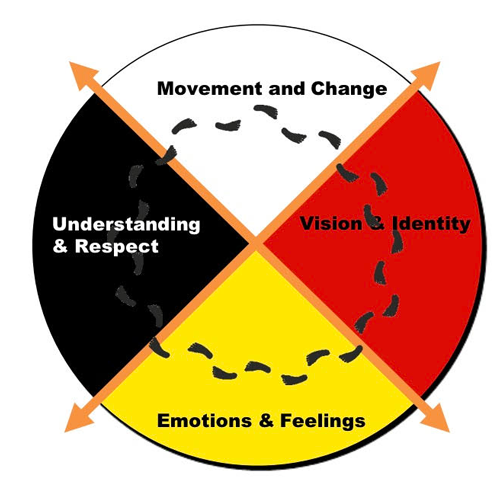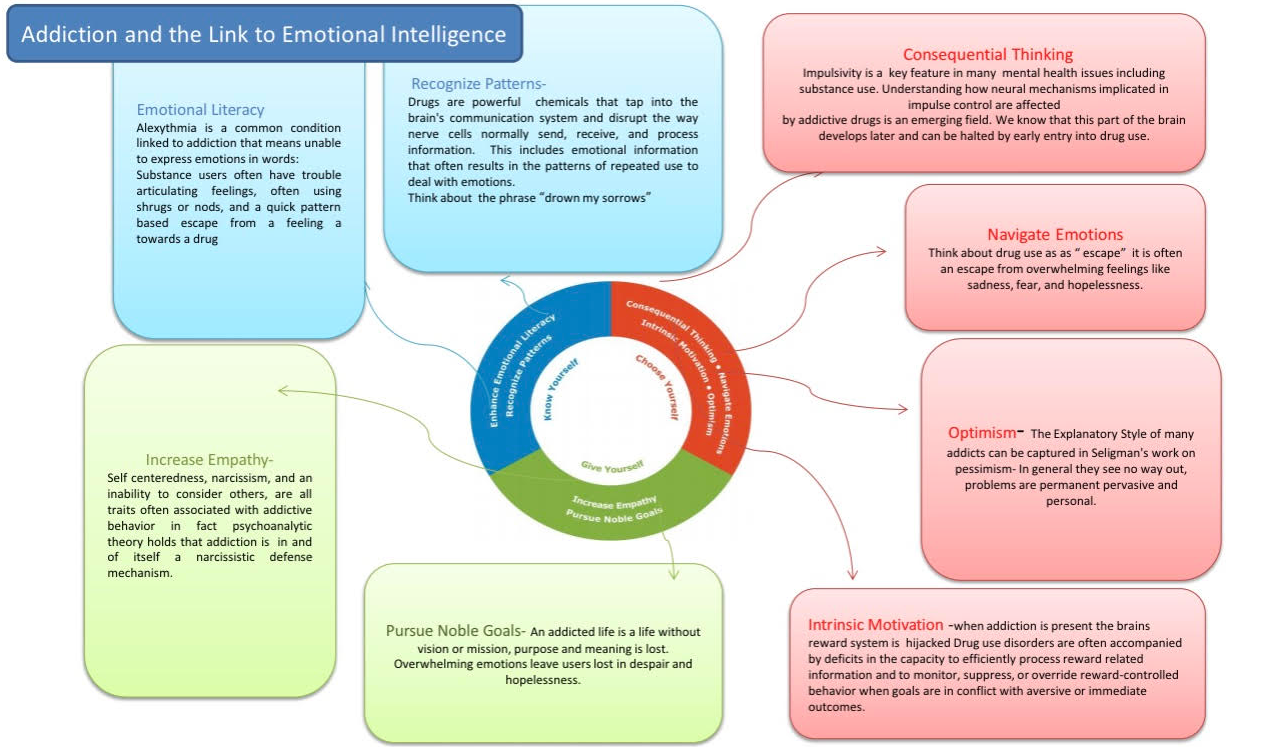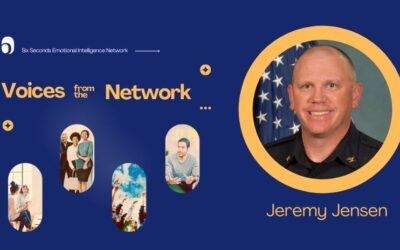Imagine a community communities where health disparities and intergenerational trauma are pervasive. A teen starts “huffing” solvents, so desperate to escape, or to feel something other than disconnection, that the 1-in-10 chance of death seems irrelevant. Western medicine says the brain damage is irreversible. Is there a path to wellbeing?
Debra Dell, coordinator of the Youth Solvent Action Committee, YSAC, has seen first hand that healing is possible — she says that at the core, the work is about reconnecting people to themselves in spirit, emotion, mind, and body… the four directions of the Medicine Wheel. “Indigenous cultures all over the world have strong models of healing and holistic health pursuit,” Dell explains. “In our programs, reconnecting with culture is a core intervention. The research has identified four key goals: hope, purpose, meaning, and belonging.” These are built through a journey around the four directions of the Medicine Wheel.
Emotional Intelligence & the Medicine Wheel
The project integrates the competencies of emotional intelligence with traditions of the Native cultures including the Medicine Wheel. This approach raises counselor’s effectiveness and empathy and helps the youth see a way forward to health and wellbeing. The centres embracing EQ have better client retention. In addition, emotional intelligence has become an essential toolset for the counselors’ self-care, which leads to better work satisfaction rates, and an increased capacity to be present in the complexity and challenge of recovery.
While YSAC has seen tremendous success, it’s incredibly difficult work. Dell explains, “This work can be overwhelming, and it is easy for hopelessness to creep in if we are not constantly navigating our emotions, and finding our optimistic spark.” Just as for the children, the counselors and leaders need hope, purpose, meaning & belonging — which are fueled, in part, by practicing the skills of emotional intelligence.

At YSAC, the Medicine Wheel is used to link the four directions to four stages of growing wellbeing. Spirit, in the east, is about building a vision & identity of health and wholeness. In the south, we process emotions & feelings about that identity. Then in west, understanding builds and we find respect for self and others. Then in the north, we integrate the learning toward physical health which leads to change. There’s a video at the end of this article which explains this model in more depth.
The Power of Hearing the Story
 “I started to tear up thinking about which story to share… I started thinking about a young man who’s grief over his whole family die tragically was so deep that he strategically sniffed gas each night at 9 pm, to hallucinate having tea with his grandmother — it was his way of ‘finding emotional normal,'” says Dell.
“I started to tear up thinking about which story to share… I started thinking about a young man who’s grief over his whole family die tragically was so deep that he strategically sniffed gas each night at 9 pm, to hallucinate having tea with his grandmother — it was his way of ‘finding emotional normal,'” says Dell.
“Or the young man who told me he wished he had never learned about Fetal Alcohol Spectrum Disorder (FASD) in school (the presentation caused him to self-diagnose), when I asked him why, he told me, ‘because now I know everything I’ll never be able to do.'”
Both of these stories, and hundreds of others like them, taught us, as addictions professionals, that we had to go deeper about understanding the emotional impetus for the trajectory into and sustenance of drug use. The second boy taught us how important it is to consider labels, and stigma and pessimism about change… they both had powerful impact on the way we do things today. So these are some stories, but the lesson in them is that knowing these youth, really knowing their stories, helped us to build programs that go deeper into teaching emotional intelligence, and management.”
Youth from many First Nations (aboriginal) peoples are struggling to overcome addiction to inhaling solvents and other substances – which can cause brain problems and learning issues. Debra Dell is a co-coordinator of the Youth Solvent Action Committee (YSAC) a network of Youth Residential Treatment Centers spread throughout various regions of Canada, supporting hope and healing in their communities. Here’s more of their story.
Six Seconds CEO Josh Freedman spoke with Debra Dell about emotional intelligence at YSAC, the Youth Solvent Addiction Committee about the Medicine Wheel, emotional intelligence, and what keeps Debra and the counselors going in this life-changing work.
In their EQ training, many of the counselors talk about how they’ve become detached from their own emotions… and in the training, they reconnect with their own feelings. Why is this significant?
We adopt the model of know yourself first. By taking the training in a first person way, they understand it more deeply, they see how easy it is to become detached. Addiction is all about either wanting to feel better or numbing a pain.
Many people don’t know about solvent addiction. What is it, how much and where is it happening?
Solvent Abuse and or Solvent Addiction and Inhalant abuse are terms that are used interchangeably to describe the practice of purposefully breathing in (huffing or sniffing) the fumes from a variety of common household products, with the intent to get high. This practice is not the same as other forms of intentional pleasure seeking through intoxication; for the simple reason that the products inhaled are not intended for human consumption.
The solvent user risks several debilitating effects such as loss of motor skills, seizures, diarrhea, abdominal pain, anxiety, irritability and even death from a single use. Chronic inhalation can be addictive and may result in damage to internal organs, peripheral nerves and failure of the liver and kidneys…In the 2004 Canadian Addiction Survey, 1.9% of males 15 years and older and 0.7% of females reported use of an inhalant in their lifetime — an increase from 1.2% and 0.3% respectively in 1994.
In the 2004 study, the majority of individuals (67%) reported first using inhalants between 12 and 16 years of age. Thirteen percent used before the age of 12 and 19% at age 17 or older.
In the Western medical literature, solvent addiction is considered to be essentially un-treatable due to brain damage. Does the YSAC approach agree with this, and why?
Not at all. Youth who use solvents often have histories of abuse and malnutrition. All of these things affect the brain in a negative way, we fully believe in neurogenesis and have seen amazing success in terms of youth recovering brain function both in physical way but also in intellectual ways. (1.4 grade levels in math and reading in 6 months of treatment).
Why was YSAC originally interested in EQ training?
In all of our work with addicted I wanted to ensure we were collecting outcomes. We had some very specific outcomes for physical, spiritual, and mental aspects of the medicine wheel, but we were looking for some specific ways to capture emotional change. We found six seconds through a Google search in 2001. Staff from four YSAC Centers took level one emotional intelligence certification training that year, and began incorporating more specific tools in programs. Two of us have continued to take additional six seconds training, to the masters class level and beyond.
What is your own experience with the role of emotions in recovery from addiction?
I can remember the first time I tried to get an emotional intelligence course accredited under the government addictions certification. They wrote back to me and asked me to be more specific about what on earth emotions had to do with addiction. I wanted to simply write “ everything” but instead I developed a full response.
For us the Six Seconds model of emotional intelligence fit so well with medicine wheel teachings because the common goal is a whole and healthy person. Dell shared this slide, illustrating the links between the Six Seconds Model of emotional intelligence and the work of addictions recovery:
You’ve seen tremendous success in the YSAC approach compared to what was done before. What are some of the successes, and why is it happening?
The successes have spanned everything from client outcomes to staffing and leadership successes. Each year we teach at least one 5 days course, we have branched to adding a leadership EI course for executive directors, family courses for those who are working with family units etc. With our partners we have written newer EI based prevention programs (Buffalo Riders, Strength Based addiction Treatment ) Not only has it helped with staff competency but it has aided us so much in attempts to teach mental health and addiction links.
In some of the communities you serve, addiction is widespread, and some people have all-but-given-up on healing. How is EQ helping your staff and clients continue in this face of this kind of challenge
The training is like a great big backpack of tools. Staff feel prepared to handle different levels of crisis. We really have a full suite of training and tools now.
 Could you talk a bit more about how the work affects counselors, and the importance of them feeling renewal: What is the role of Exercising Optimism, and the importance of care-for-caregivers?
Could you talk a bit more about how the work affects counselors, and the importance of them feeling renewal: What is the role of Exercising Optimism, and the importance of care-for-caregivers?
Counselors come to this work generally because they have understanding of their deep purpose. They see themselves as helpers first and foremost. Sometimes as counselors we find this path as a result of our own personal traumas. All of this weighs heavy on hearts and minds.
The Six Seconds EQ training helps caregivers, counselors, helpers to center themselves in the understanding of care for the caregiver. Knowing themselves helps them to uncover stress points and take proactive and preventative action. This work can be overwhelming, and it is easy for hopelessness to creep in if we are not constantly navigating our emotions, and finding our optimistic spark.
How does the Six Seconds Model, with the three “pursuits” of Know Yourself, Choose Yourself, Give Yourself, fit with teachings from First Nations’ cultures?
It fits extremely well with many of the medicine wheel or seven grandfather teachings. In fact we teach about the strong linkage in all the courses. So many traditional ceremonies are connected to developing a deeper sense of self- knowledge, belonging, or purpose.

YSAC has been part of a nationwide effort to re-envision treatment to honor the cultures of First Nations people and build more meaningful collaboration between government and communities in the Honoring our Strengths project. Given a past history of conflict and judgment, what’s the role of emotional intelligence in moving this dialogue forward?
It plays a pivotal role in all our relationships, negotiations and action planning. We use concepts from EI training sometimes without even realizing it. If there is one thing I have noticed in all the SEI assessments I have done, it’s that so many of the
people who come to this work have strong empathy scores.
Our challenge many times is to get people to balance the self-care aspect of living in empathetic space. That means honoring a counselors own needs by navigating through challenging emotions, and really taking the wisdom that that place has to offer, it’s in this pursuit that we find the energy and motivation to live with purpose.
What’s your own Noble Goal, and how does that support you in this work?
My own noble goal is always a wok in progress. Definitely it’s about helping people uncover hope and true purpose. Understanding why I do this work, is a crucial part of engaging my own intrinsic motivation. When you really believe the work is connected to purpose (noble goal) it’s really not work at all , it is just a way of being, a way of showing up each day for all the things that need to get done.
As you continue to work to weave EQ into the fabric of support for healthy people and healthy communities, what are the next big challenges?
In a practical way we do have a challenge to keep up with all the requests for training and program development. In more of a visionary way we hope to make stronger linkages between EI and all the other projects we are involved in, there is so much work to do, but we are also making giant steps towards hope.
If you could train a million adults who counsel and teach young people today — what are the three most important strengths you’d want those adults to build? Why?
We have a big research project in Canada, the findings tell us hope, belonging, meaning and purpose are crucial conditions for holistic help. I would teach counselors to truly model each of these four aspects. Beyond that I think the Six Seconds model echoes some of this. I’d like to see authentic, relational presence, empathy, and a vision for change.
In the words of Carol Hopkins, Executive Director of the Thunderbird Partnership Foundation, a division of the National Addictions Partnership Foundation:
“When you cut off your emotions, and try to solve problems without them, it doesn’t work. For me, family I come from, the land I come from, and the nation I come from. What drives and informs your vision and purpose in life?”
You can view a video of Carol Hopkins, of YSAC, when she presented at Six Second’s EQ conference at Harvard, explaining the Medicine Wheel and the Four Directions and how emotions and emotional intelligence are part of these teachings:
What’s new in emotional intelligence?
Emotional Intelligence at Work: The Free, Easy Win Most Managers Are Missing
Gallup study compares the biggest gaps in employee vs. manager perceptions. What are managers’ worst blind spots? What are easy wins they could do better to improve team performance?
Is Boredom Bad for Kids? Emotional Intelligence Education News
Let’s unpack boredom and how emotional intelligence can help you with tips to support bored children (and keep your cool!). Keep reading for EQ research and resources you can use for you, your faculty and students.
Effective Emotional Intelligence Coaching: 4 Questions to Improve Client Outcomes with Social and Cultural Insights on Emotions
Improve your emotional intelligence coaching by understanding the social and cultural influences on emotions. Ask these 4 key questions for more effective client relationships
Krish and Anabel: SEL Pioneer and Mentee Share 6 Life Lessons on Empathy, Integrity, and Emotional Intelligence
What are 6 life lessons you’ve learned? Dr. Anabel Jensen, SEL pioneer and Six Seconds President, explores this important question with her 16-year-old mentee.
Voices from the Network: Jeremy Jensen
In this Voices from the Network, we sit down with Police Chief Jeremy Jensen, who is doing emotional intelligence training with his officers in Dubuque, Iowa.
Emotional Intelligence at Work: Is There Hope for Toxic Workplaces?
The remarkable transformation at Westcomm Pump offers a blueprint for turning around workplaces with depleted morale and trust issues, using the Team Vital Signs assessment.
- Coaching Through the Emotional Recession: Three Practical Tips for Trauma-Informed Coaching - May 1, 2024
- Knowing Isn’t Coaching: Three Emotional Intelligence Tools for Professional Coaches - April 3, 2024
- Coaching Down the Escalator: 3 Emotional Intelligence Tips forCoaches to Reduce Volatility & De-escalate Conflict in a Polarized World - March 6, 2024








